Bulgaria’s earliest inhabitants were the Thracians. Originally nomadic herders, they settled in Bulgaria’s fertile, well-watered lands. There, they cultivated wheat, barley, and grapes, raised sheep, horses, and goats, and collected honey.
Later, the arrival of the Slavs and Proto-Bulgarians in the Balkans further enriched the local culture and diet. Notable examples include fermented dairy and grains such as yogurt and bozo. Bulgaria also traded with Greece, Byzantium, and the Middle East over the following centuries, introducing rice, new spices, and novel cooking techniques to Bulgarian cuisine.
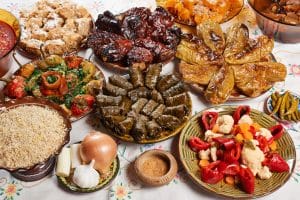
Ottoman rule (14-19th centuries) profoundly impacted Bulgarian cooking, being the base inspiration for many Bulgarian national dishes such as banitsa, kebapche, and baklava. The Ottomans also popularized slow-cooked stews, grilled meats, and rich desserts. During this time, Bulgaria’s rural population continued relying on homegrown vegetables, beans, and dairy, while markets in larger towns provided access to exotic spices and other goods from the vast Ottoman trade network. Livestock production remained partly focused on sheep, but they were less used for meat as the value of wool rose. Cattle became popular for dairy and labor, and pork’s increased use was in part due to the fact that Muslim Ottomans did not tax or requisition it. Fish and seafood dishes are common in areas along the coast and many rivers, but less so in inland areas.
Although large-scale farming and industrial food production boomed under Communist rule (1946-1989), and continues to grow today, Bulgaria is still known for growing much of its locally used fruits and vegetables, especially tomatoes and peppers, on small family plots that specialize in local varieties. One can see local fruits and vegetables in just about any outdoor produce market. These more flavorful and traditional crops are key to producing the recipes, many still using ancient cooking methods, that Bulgaria takes pride in.
Ayran: (Drink) Yogurt is mixed with cold water and a pinch of salt and served chilled. Popular in the summer, it pairs well with savory dishes like banitsa and kebabs, offering a refreshing contrast to rich or spicy foods.
Baklava: (Dessert) A very sweet treat originating from Turkey, it is composed of thin layers of phyllo pastry, chopped nuts such as walnuts or pistachios, and soaked in sugar syrup. Baklava in Bulgaria is also commonly made with honey and enjoyed around the holiday season.
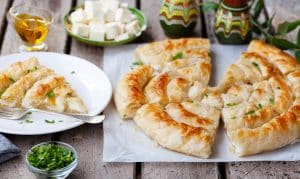
Banitsa: (Breads) Bulgaria’s national dish. Banitsa is a flaky pastry made by layering phyllo dough with a mixture of eggs, sirene cheese, and yogurt. Small variations can be made, such as the addition of spinach or pumpkin. Banitsa is often shaped into a spiral and, on New Year’s, it is filled with small fortunes. Best served with a dollop of yogurt.
Biskvitena torta: (Dessert) This no-bake cake is made by layering cookies (such as tea biscuits or arrowroot cookies) with a custard-like cream of egg, milk, butter, sugar, and sometimes cocoa or vanilla. Optional toppings might include walnuts and chocolate.
Bira: (Beverage) Although many other brewed drinks have much longer histories in Bulgaria, beer is now the most consumed alcoholic beverage by volume. Most of Bulgaria’s major breweries were founded in the 1880s. These include Kamenitza, Zagorka, and Shumensko – all of which remain in operation today and are household names. Bulgaria has also seen a rise in craft beer culture, particularly in urban centers, often using local hops, honey, and/or herbs to create something truly local. Beer is usually consumed socially and accompanied by snacks like meats, sirene, and tsatsa.
Bob Chorba: (Soups) A hearty bean soup made with white beans, onions, carrots, tomatoes, and red peppers, often flavored with paprika and savory herbs like spearmint or chubritsa. A staple of Bulgarian monastery cuisine and religious fasting days, it is most often prepared without meat.
Bobena Salata: (Salad) This simple yet flavorful dish is made with white beans, chopped onions, bell peppers, parsley, and sometimes tomatoes. Dressed with olive oil, vinegar, and salt, it has a fresh and tangy taste. It is often served as a side dish alongside grilled meats like kebapche and kyufte.
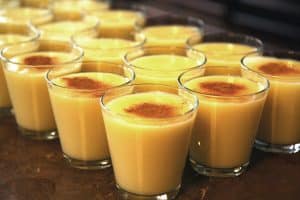
Boza: (Drink) A thick, fermented malt drink made from wheat or millet. It has a strong sweet-sour flavor, an alcohol level under 1% (about the same as fresh yogurt), and just enough ferment to promote gut health. You’ll commonly see it paired with banitsa at breakfast.
Chubritsa: (Seasoning) A staple of the Bulgarian flavor palate, chubritsa has a strong, distinct aroma, somewhat similar to thyme. In English, it is most often known as “summer savory.” Bugarians use it to season almost everything.
Cumin: (Seasoning) Cumin, or “kimion” in Bulgarian, is typically used to season barbecue meats or ground meats like kebapche and kyufte. It adds an earthy flavor.
Dill: (Seasoning) This herb, known as “kopur” in Bulgarian, is used in many light Bulgarian dishes like soups and salads. It is a key component of the yogurt-based tarator soup, classic shopska salata, and with roasted potatoes. Additionally, dill and lemon are commonly used in fish dishes to brighten the flavor.
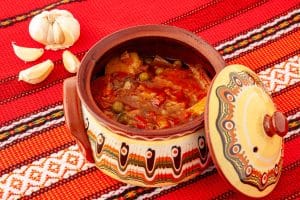
Gyuveche: (Main Dish; Cooking Technique) “Gyuveche” is the name for both a hearty traditional Bulgarian main dish and the small ceramic pot in which it is baked. The entree can be made with meat, potatoes, and vegetables, and sometimes an egg is cracked on top for the last couple minutes of cooking. Ceramic gyuveche pots can be spotted in any Bulgarian souvenir shop, often painted with lovely, colorful designs.
Izvara: (Dairy) Made from the whey left over after cheese production, izvara has a slightly grainy texture between that of feta and ricotta. It can be eaten fresh or used in both savory and sweet dishes. Common uses include fillings for pastries like banitsa, spreads, or even as a light protein-rich snack with honey.
Kachamak: (Porridge; Side Dish) A creamy polenta, served with butter. It can be sprinkled with sweet paprika and/or crumbled sirene cheese. Served as a side or sometimes eaten for breakfast.
Kapama: (Main dish) Kapama is cooked in a traditional Bulgarian gyuveche clay pot and is assembled by layering kiselo zele, aromatics, rice, and meat fillets until the pot is almost full. A spiral sausage and a dough that covers the pot opening are placed as the final layers. The dish is then slow baked with the pot lid on for several hours. Traditionally, at least three meats must be used.
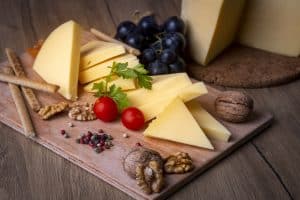
Kashkaval: (Dairy) This is a semi-hard yellow cheese made from cow’s or sheep’s milk, with a smooth, slightly nutty flavor. It is commonly eaten on its own, melted over dishes, or used in pastries and sandwiches. In Bulgaria, kashkaval pane (breaded and fried kashkaval) is a popular appetizer.
Kavarma: (Main Dish) Meat, traditionally pork and/or chicken, is slow-cooked with onions, peppers, tomatoes, and other vegetables in a gyuveche with a blend of spices and herbs. It is cooked until nearly all the excess moisture has boiled off, leaving a very flavorful, pungent dish. It is often served with rice or bread.
Kebabs: (Main Dish) Marinated chunks of pork, chicken, or lamb are skewered and grilled over an open flame. The marinade typically includes oil, garlic, paprika, black pepper, and sometimes yogurt or wine to tenderize the meat. Kebabs are commonly served with fresh salads, roasted vegetables, and/or bread.
Kebapche: (Main Dish) Ground meat, typically a mix of pork and beef, seasoned with black pepper, cumin, and salt, is shaped into a long, sausage-like form and grilled until crispy on the outside. Typically served with hand-cut potato fries, sirene cheese, and lutenitsa (a pepper and tomato spread), it is a favorite street food in Bulgaria.
Kiselo Mlyako: (Dairy) “Kiselo mlyako” directly translates to “sour milk,” which accurately describes the sour, tangy flavor of Bulgarian yogurt. Bulgarian yogurt is internationally recognized, and even the lactobacillus bulgaricus and streptococcus thermophilus bacteria cultures come from Bulgaria. “Kiselo mlyako” can be served with just about anything, including rice, sarmi, mixed into soup to make it creamier, a dollop with baked pumpkin and dusting of cinnamon, etc.
Kiselo Zele: (Ingredient; Side Dish) Whole or shredded cabbage heads are salted and then allowed to ferment. The result is a tangy, probiotic-rich side dish often used in winter meals. It is a key ingredient in traditional Bulgarian dishes like sarmi and kapama.
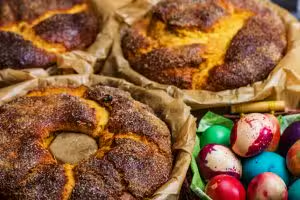
Kozunak: (Breads) Made with flour, eggs, sugar, butter, and milk, often flavored with vanilla or citrus zest, this is a light yet rich bread. It is traditionally prepared for Easter and nearly any other special occasion as a braided circular or oblong loaf that sometimes includes raisins, nuts, and/or chocolate. The dough is kneaded and allowed to rise multiple times, giving it a light, fluffy texture.
Krem Karamel: (Dessert) A custard mixture made from eggs, milk, sugar, and vanilla is poured over a layer of caramelized sugar and baked in a water bath until set. Once cooled and flipped onto a plate, the caramel forms a sweet syrup that coats the custard. You’ll see this beloved dessert on most Bulgarian restaurant menus.
Kyopolou: (Condiment) This chunky spread with Turkish influence is made from roasted eggplant and red peppers, sometimes tomato, sunflower or olive oil, lemon, and lots of garlic. Kyopolou’s strong and distinct flavor makes it a great pairing with bread and cheese and as a side to grilled meats.
Kyufte: (Main) Ground pork or a mix of ground pork and beef is mixed with onion, cumin, black pepper, salt, and parsley. Shaped into a patty, it can be grilled, pan-fried, or baked. They are often served with a side of lutenitsa, potato fries, or fresh salad.
Lokum: (Dessert) Lokum is originally a Turkish treat typically known as “Turkish delight” in English, but it has been integrated into Bulgarian culture as well. Sugar syrup, starch, and flavorings are combined and allowed to set into a sweet jelly. In Bulgaria, rose, pomegranate, walnut, and honey are common favors. Lokum is often served with strong Bulgarian coffee.
Lukanka: (Appetizer) This dried, cured sausage is made from minced pork and beef, seasoned with salt, cumin, black pepper, and other spices, then pressed into a slightly flattened shape as it dries.
Lutenitsa: (Condiment) Lutenitsa is a classic childhood favorite spread of many. A base of roasted red peppers is blended with tomatoes and aromatic spices. It can be eaten on toast with sirene cheese or as a condiment with meat or fried potatoes (almost like ketchup). Many families prepare lutenitsa at the start of fall, just after the summer growing season for peppers and tomatoes has ended.

Medenka: (Dessert) A favorite treat of many, the “medenka” is a soft honey cake dipped in chocolate. Its comforting flavor comes from the combination of honey (“med” in Bulgarian) and cinnamon.
Mekitsa: (Breakfast) A popular breakfast item. Deep-fried dough commonly paired with powdered sugar or jam for a sweet version or sirene cheese for a salty version.
Meshana skara: (Main Dish) “Meshana skara” translates to “mixed grill.” It is a platter of various grilled meats, i.e. kebapche, kyufte, kebab, and steak. Common sides are potato fries, lutenitsa, bean salad, and beer!
Midi po burgaski: (Main Dish) Mussels Burgas-style comes from the city of Burgas on the Black Sea. In this dish, mussels are prepared with white wine, rice, vegetables, and herbs. The dish is best known along Bulgaria’s coast, where the mussels are plentiful and harvested fresh.
Mish-mash: (Breakfast) Tomatoes, onion, peppers, and herbs are chopped and cooked into scrambled eggs. A simple yet comforting dish.
Musaka: (Main Dish) A casserole made of potato, ground meat, eggs, and vegetables. Musaka is common in other Balkan countries, such as Greece, however the Bulgarian version always uses only potatoes to layer the meat rather than eggplant or eggplant and potatoes, as can be found in other cultures.
Ovcharska salata: (Salads) “Shepherd’s salad” consists of tomatoes, cucumbers, peppers, mushrooms, sirene cheese, ham, egg, and often olives, all dressed in olive oil and vinegar.
Palachinki: (Dessert) Thin crepes with various fillings, such as nutella, jam, and fruit. They can also be filled with sirene cheese and/or ham for a savory alternative.
Panagyurishte-style eggs: (Breakfast) Poached eggs are served over a bed of yogurt mixed with garlic, then drizzled with melted butter and sprinkled with sweet paprika. This dish is creamy, tangy, and slightly spicy, often served with crusty bread for dipping. It originates from the town of Panagyurishte and is a popular breakfast or light meal in Bulgaria.
Parlenka: (Breads) A buttery, fluffy, yeasted, grilled flatbread. It is a popular bread served with meals in restaurants, where it is often brushed with garlic butter. It can also be stuffed or topped with kashkaval or sirene cheese.

Paprika: (Seasoning) Paprika is a key spice in Bulgarian cuisine, made from dried and ground red peppers. It comes in various types, including sweet, smoked, and hot, and is widely used in dishes like stews, grilled meats, and soups. Sweet paprika is most common.
Patatnik: (Side dish) Patatnik is a traditional potato pancake from the Rhodope Mountains. Grated potatoes are mixed with onions, eggs, salt, and savory herbs. The mixture is pan-fried or baked into a thick, golden-brown pancake with a crispy crust and soft interior. This rustic dish is a regional favorite, often enjoyed with yogurt.
Pile i oris: (Main dish) The name translates directly to “chicken and rice.” It is made by first toasting rice and savory aromatics and then baking it with chicken, onions, and carrots. The rice absorbs the chicken broth, creating a rich and flavorful meal. It is often served with a side of yogurt or fresh salad.
Pitka: (Breads) A traditional, round pull-apart bread made from flour, yeast, milk, and butter. Pitka has a soft, fluffy texture and is sometimes decorated with intricate patterns. Some versions include a hidden coin for good luck, especially during Christmas and New Year’s celebrations.
Printsesa: (Breakfast) A tasty, salty open-faced sandwich. Combine ground meat and kashkaval cheese, spread it onto a slice of bread, and then broil until the bread is toasted, meat is browned, and cheese is melted. Funnily enough, the name translates to “princess.” It is a childhood favorite in Bulgaria.
Pulneni chushki: (Main dish) Baked red peppers stuffed with rice, onion, parsley, and sometimes mince meat (pork and/or beef) or other vegetables or mushrooms. The stuffed peppers are then baked in a tomato-based sauce or served with yogurt.
Purzheni filii: (Breakfast) Bulgaria’s “French toast.” Slices of bread are dipped in beaten egg and then fried. Most commonly served with powdered sugar, honey, or grated sirene cheese.

Rakia: (Spirit) Rakia is a popular fruit brandy known for being the alcohol of the Balkans. Common fruits to make it are plums, grapes, and apricots. Be careful because it is strong – potentially over 60% if homemade!
Ribena chorba: (Soup) This fish soup is typically made with freshwater fish like carp or trout, although sea fish can also be used. The soup is simmered with vegetables such as carrots, onions, tomatoes, and celery, and often seasoned with black pepper, bay leaf, parsley. Sometimes a touch of vinegar or lemon juice is added for brightness. It’s especially popular in coastal and riverside regions and is served hot.
Ribnik: (Main dish) Ribnik is a traditional dish prepared on Nikulden (St. Nicholas Day). This holiday is celebrated on December 6, which concludes the autumn fishing season, and honors St. Nicholas for protecting sailors and fishermen. The main ribnik dish is carp (said to be the servant of St. Nicholas). It is stuffed with rice, walnuts, raisins, and aromatics. The fish is usually wrapped in dough and traditionally baked in the oven alongside two loaves of bread. The bones were traditionally kept and buried in farm fields, burned in the hearth, or dropped in the river or sea to ensure bounty in the coming year.
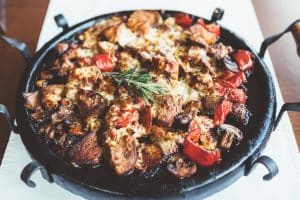
Sach: (Main dish; Cooking technique) A “sach” is a flat iron (or clay) plate with handles. The dish cooked on it, which usually includes various kinds of meats (chicken fillets, offal, and/or pork) and plenty of vegetables, is are usually brought to the table sizzling, straight from the oven.
Sarmi: (Side dish) Cabbage leaf rolls filled with rice, minced vegetables, and sometimes meat. Sarmi are a common vegan side served on Christmas Eve, which is a fast day for Bulgarians. “Lozovi sarmi” use grape leaves instead of cabbage.
Sharena sol: (Seasoning) “Colorful salt” is a spice mix unique to Bulgaria consisting of salt, sweet paprika, dried summer savory (chubritsa), and sometimes other spices such as fenugreek. It is not meant to be cooked but rather used as a finishing salt on just about anything. Most commonly, it is sprinkled over toast with butter or melted cheese (it goes great on a printsesa sandwich!).
Shkembe chorba: (Soups) This soup is made by slow-cooking beef or pork tripe in a rich broth of milk, garlic, vinegar, and paprika. It is known for its strong flavor and is often eaten as a hangover cure, typically served with extra garlic, hot chili flakes, and vinegar for seasoning.
Shopska salata: (Salads) Bulgaria’s best-known and most common salad consists of tomatoes, cucumbers, peppers, onions, and sirene cheese dressed with sunflower or olive oil and vinegar. Its red, green, and white colors resemble the Bulgarian flag, making it a symbol of national pride.
Sirene: (Dairy) This crumbly, salty white cheese, made from cow’s, sheep’s, or goat’s milk, is similar to feta. It is a staple in Bulgarian cuisine, used in salads, pastries like banitsa, or simply served with bread.
Soleti: (Appetizer) “Soleti” are light pretzel sticks and are one of the most common snacks in Bulgaria. The name comes from the word “sol,” which refers to salt in many cultures. If purchased in a store, “Hrus Hrus” (named for the sound it makes as you eat it) and “Zlatna Dobrudja” (which translates as “A Golden Good Morning”) are the leading brands.
Snezhanka: (Salads) Translating to “Snow White,” this salad is like a thicker version of tarator soup. It is made with strained yogurt, cucumbers, dill, garlic, and olive oil – sometimes with the addition of pickles and/or walnuts.
Spearmint: (Seasoning) Bulgarians call this “djodjen.” It is commonly used in bean and lentil dishes like bob chorba. Its slightly sweet and peppery flavor also pairs well with meat.
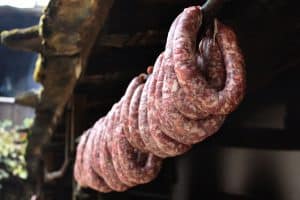
Sujuk: This dry, cured sausage made from beef is spicy with cumin, black pepper, and paprika. It is shaped into a horseshoe and has a firm texture and intense flavor. It is often sliced thin and eaten as an appetizer with cheese and rakia or lightly fried and served with eggs.
Supa topcheta: (Soups) A comforting soup made with small beef or pork meatballs, potatoes, carrots, and onions, all cooked in a light broth. The soup is sometimes thickened with an egg-and-yogurt mixture for extra creaminess. “Topche” in Bulgarian means “little ball.”
Svinsko c zele: (Main dish) A dish of slow-cooked pork and cabbage, this dish is often baked or stewed with paprika, tomatoes, and bay leaves. The pork becomes tender as it absorbs the flavors of the cabbage and seasonings.
Tarator: (Soups) A cold, yogurt-based soup with grated cucumber, dill, garlic, and sometimes topped with walnuts and olive oil. Its creamy, tangy taste makes it a perfect complement to grilled meats and is a wonderful refresher on a hot summer day.
Tikvenik: (Dessert) A sweet version of banitsa filled with baked pumpkin, sugar, and walnuts.
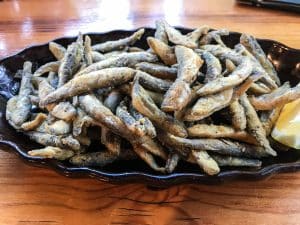
Tsatsa: (Side dish) Tsatsa is the Bulgarian version of “fish and chips” and features whole floured and fried sprats, fried potatoes, and grated sirene cheese. It pairs very well with beer.
Turshiya: (Salads) A winter pickled salad consisting of carrots, cauliflower, green tomatoes, and pickle cucumbers. There are some variations, such as tsarska (royal) and selska (village) turshiyas, and the differences come down to variations in the pickled vegetables. Celery leaves and dill are common aromatics in the pickling brine.
Yufka: (Breakfast) A thin, flaky, egg pasta that cooks quickly and is topped with sirene cheese and often butter.
You’ll Also Love

Enyovden: Midsummer in Bulgaria
Bulgaria has been on my list of places to visit for a while. I had planned to visit it while enroute to somewhere else, as a long layover. I never really thought about it in terms of a multi-day destination. However, in June, 2019, an opportunity to spend a few days there appeared and I […]
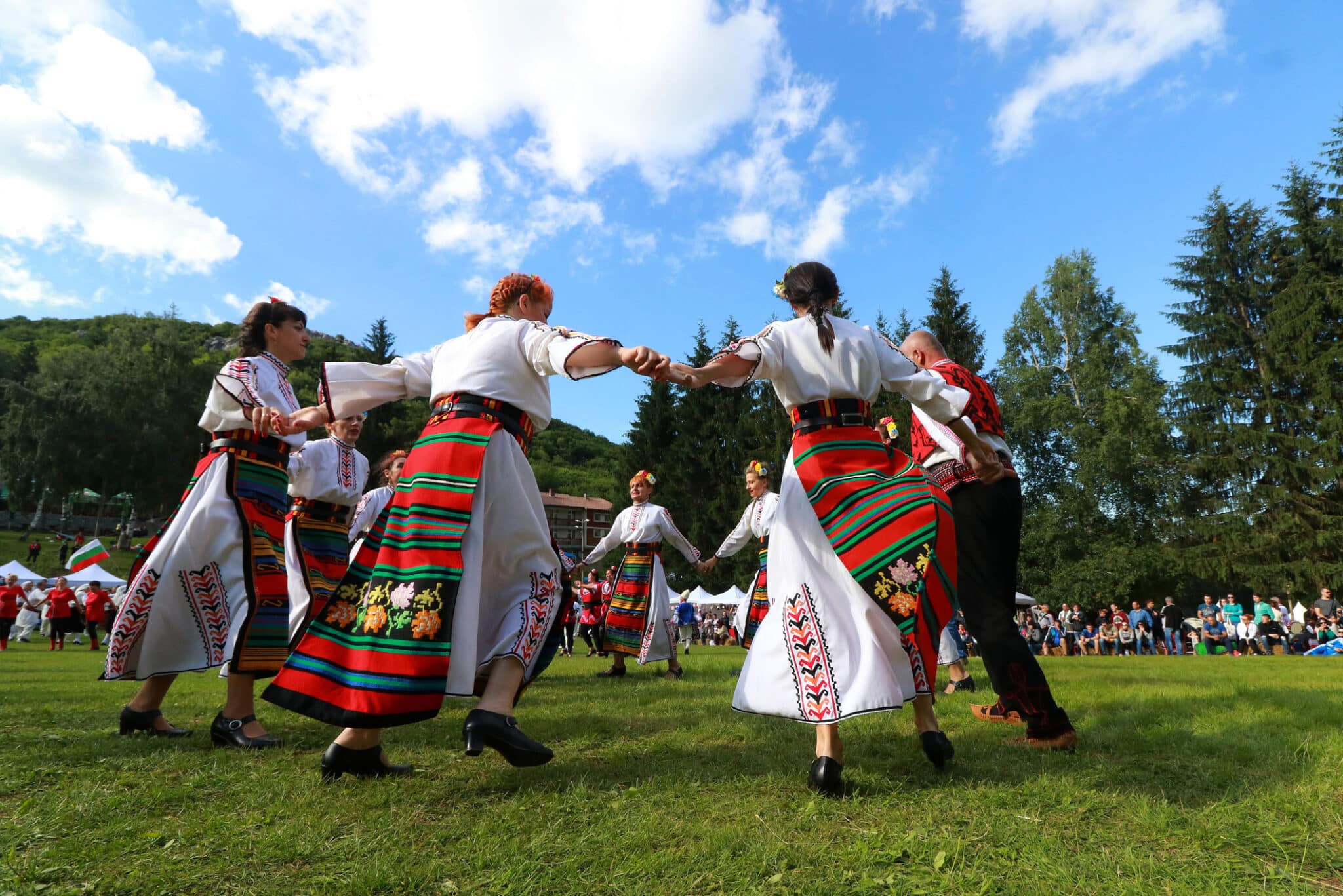
The Talking Bulgarian Phrasebook
The Talking Phrasebook Series presents useful phrases and words in side-by-side translation and with audio files specifically geared to help students work on listening skills and pronunciation. Each entry below, divided by category, features an English word or phrase in the left column and its Bulgarian translation in the right. In the center column for […]
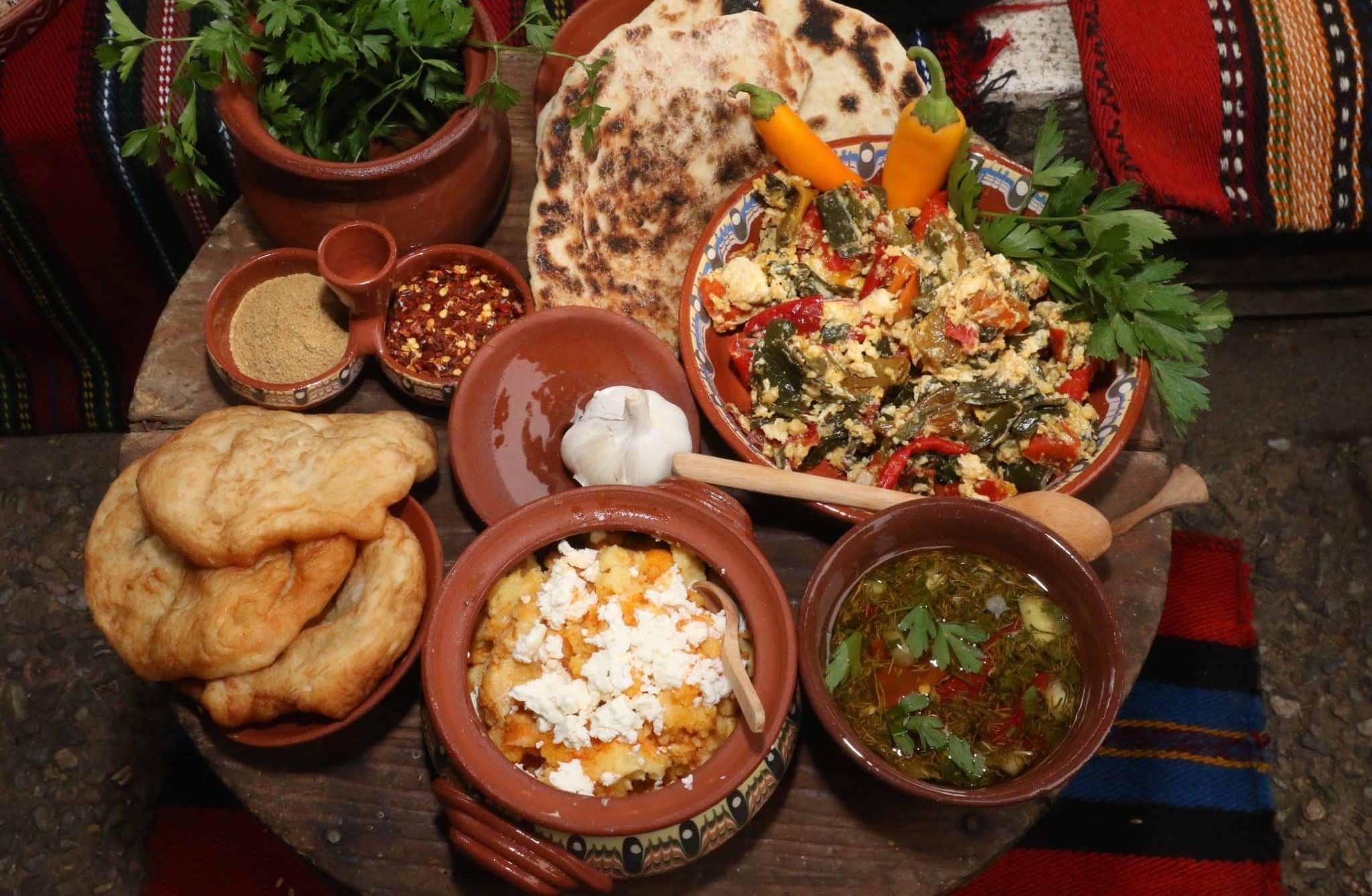
The Bulgarian Food Dictionary
Bulgaria’s earliest inhabitants were the Thracians. Originally nomadic herders, they settled in Bulgaria’s fertile, well-watered lands. There, they cultivated wheat, barley, and grapes, raised sheep, horses, and goats, and collected honey. Later, the arrival of the Slavs and Proto-Bulgarians in the Balkans further enriched the local culture and diet. Notable examples include fermented dairy and […]

Bulgarian Holidays 2025: A Complete Guide
Bulgarian holidays focus in large part on the country’s long road back to being an independent state after centuries of being part of the Ottoman Empire. They also feature many holidays connected with the Bulgarian Orthodox Church, which helped preserve Bulgarian culture during that occupation. Saint’s days and name days are of particular importance. Lastly, […]




